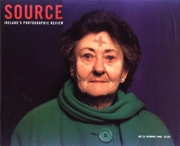A Moving Display Cabinet
'All Zones Off Peak' by Tom Wood was at The Orchard Gallery, April, 1999
Review by Richard West
Issue 19 Summer 1999
View Contents ▸
Tom Wood has been photographing around Liverpool for over fifteen years from buses and bus stops. His subject might be the changing face of urban Britain (from black and white to colour), people on pavements or the fortunes of Liverpool but his manner appears somewhat oblique. His working method involved exposing a large amount of film over a long period from which the final work was then edited. If the ratio of film exposed to printed pictures is anything to go by these must be carefully considered images. Stanley Road, Bootle (flower streets), 1989
Stanley Road, Bootle (flower streets), 1989
This is very far from being street photography, more like the journal of a voyage; a voyage to a reef in a glass bottom boat, in a ship of fools or in a large moving display cabinet. The people look into a passing bus or look out at a waiting pedestrian. The photographer is as much the animal in a safari park as the curious visitor gazing through glass and within the bus or at the stop there is an intimacy with the fellow traveller, sharing the same space and the same perspective on the world. Only the driver - frequently seen as a tiny spectator in a wing mirror - has a God-like power to determine everyone's destination, though for him the end of the bus route is also its beginning. At the front of the bus the sign says 'DO NOT SPEAK TO THE DRIVER...'
In part the images are determined by what can be seen from a bus. From the perspective of the top deck one might be flying; from the lower deck, looking at curiously arranged shop windows. The demeanour of the passengers has about it something of the thoughtful cinema audience, watching the world outside and day-dreaming. The bus itself becomes a metaphor for seeing; with windows for eyes, not unlike a camera lens. Yet unlike a camera lens (and more in common with seeing) the passenger's reflection interposes itself. Those on the bus, including the photographer, cannot look out without seeing translucent images of themselves and the surrounding world. Sometimes these reflections are indistinguishable from that behind the glass, on other occasions they offer only the faintest trace, suggesting the dreams of those waiting for buses or a mirage of a different city. Chinatown, 1980
Chinatown, 1980
Aside from the relationship to his subject and his unusual perspective on the city, Tom Wood's photographs contain much discrete and curious detail. Like an explorer in strange parts the artist appears to choose archetypes, images that will be recognisable to us no matter how unfamiliar the environment. Old women at bus stops are found arranged in the manner of the three graces; a mother has the beatific pose of a Madonna; three women, young, middle-aged and old, stand together as if representing The Stages in Life's Way. Then there is the peculiar nature of the colour in these photographs. An image entitled Scotland Road 1992 showing a red bus, a blue shop and a yellow shop might have been produced in imitation of a modernist painting, only the run down look of the shops and the presence of a passing dog reassert the grim context. Between Chester and Birkenhead, 1989
Between Chester and Birkenhead, 1989
On the evidence of this book there has not been much to smile about around Liverpool. There is a wealth of text inscribed on shops or scrawled on walls which shows the changing preoccupations and roles of people in the city, from 'THEY THAT GO DOWN TO THE SEA IN SHIPS & HAVE THEIR BUSINESS IN GREAT WATERS' to 'KIPKINS IS UP PAUL'S ARSE'. From the buses at least, Liverpool's glory appears to be completely dissipated and its former grandeur, glimpsed sometimes in the background, no more than a facade.
'RAINBOW TICKETS MAY NOT BE USED ON MERSEYBUS' but that is not to say these photographs are entirely depressing. Even in the most humdrum of circumstances there is the suggestion of an imagined or transformed world in the thoughts of the people or merely reflected in the glass. There are also a few photographs which offer the mysterious and ghostly; identical women in white, striding in step. No matter how austere the realism the subjects of these photographs are always close to a transfigured world.
Other articles by Richard West:
Source Photo: Do we need Photography Galleries? [Blog Post] ▸
Source Photo: The New Photo Galleries: A US Perspective [Blog Post] ▸
Source Photo: List Mania: 2011 Photobook Roundup [Blog Post] ▸
Source Photo: Is There a Crisis in Art Book Publishing? [Blog Post] ▸
Source Photo: Charlotte Cotton Resigns Media Museum [Blog Post] ▸
Issue 52: Teenage Girls at the Edges of Cities at Night... [Feature] ▸
Other articles mentioning Tom Wood:






